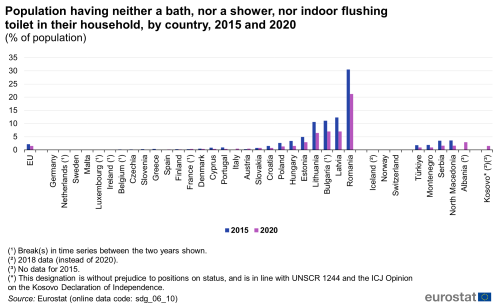Demo - Dominique - GOPA
Water use efficiency
SDG 6 also calls for a focus on water use efficiency in order to use freshwater resources sustainably and reduce water stress. The regionalised water exploitation index (WEI+) aims to illustrate the pressure on renewable freshwater resources due to water demand, which is largely affected by population trends and socio-economic developments; and climate conditions, which control the availability of renewable freshwater resources.
Water stress is low in most EU countries, but shows a strong seasonal variability
Water stress occurs when water demand exceeds available water resources at a specific place and time. Situations where the ratio between water abstraction and long-term average available water resources exceeds 20 % are generally considered as an indication of water scarcity, while values above 40 % indicate severe water scarcity, meaning the use of freshwater resources is unsustainable [1]. A look at annual national mean WEI+ values shows water stress appears to be a local phenomenon in Europe. At the EU level, the annual WEI+ is rather stable, increasing only slightly from 8.0 % in 2002 to 8.4 % in 2017.
In 2017, Spain and Greece showed water stress with mean annual WEI+ values above 20 %, while Cyprus showed severe water stress with a mean annual WEI+ value of 70 %. However, annual national values can mask regional and seasonal water stress, which is in fact common in many European regions. This is particularly the case in a number of large metropolitan areas across the continent and in southern Europe, where more than half of the population regularly experiences water stress. In southern Europe, water stress is typically greatest over the summer months, when water demand from agriculture and tourism is at its highest and precipitation is low. In contrast, metropolitan areas with high energy production tend to face water stress during autumn and winter.
Although water stress has become a constant companion in the EU, it is still a local and seasonal phenomen [2]. An assessment of river basin districts between 1990 and 2015 by the EEA concluded that, over the 15-year period from 2000 to 2015, water scarcity affected on average 14 % of the total EU territory, with the highest values observed in 2000 (21 %) and 2015 (20 %). In 2015 — a year with relatively high actual water evaporation from land surface and transpiration from vegetation and low precipitation levels — the share of the European population exposed to water scarcity was around 30 %. Most of these people were living in densely populated cities, on small Mediterranean islands and in agricultural areas of southern Europe [3].
Presentation of the main indicators
People living in households without basic sanitary facilities (such as bath, shower, indoor flushing toilet)
This indicator reflects the share of total population having neither a bath, nor a shower, nor an indoor flushing toilet in their household. Data presented in this section stem from the EU Statistics on Income and Living Conditions (EU-SILC).

Compound annual growth rate (CAGR) for the total rate: – 6.4 % per year in the period 2010–2020; – 7.4 % per year in the period 2015–2020.
Source: Eurostat (sdg_06_10)

Source: Eurostat (sdg_06_10)
Population connected to at least secondary wastewater treatment
This indicator measures the percentage of the population connected to waste water treatment systems with at least secondary treatment. Thereby, waste water from urban or other sources is treated by a process generally involving biological treatment with a secondary settlement or other process that removes organic material and reduces its biochemical oxygen demand (BOD) by at least 70 % and chemical oxygen demand (COD) by at least 75 %. Data presented in this section stem from the Water Statistics of the European Statistical System (ESS).

Compound annual growth rate (CAGR): 0.9 % per year in the period 2004–2019; 0.8 % per year in the period 2014–2019
Source: Eurostat (sdg_06_20)

Source: Eurostat (sdg_06_20)
Biochemical oxygen demand in rivers
This indicator measures the mean annual five-day biochemical oxygen demand (BOD5) in rivers, weighted by the number of measuring stations. BOD5 is a measure of the amount of oxygen that aerobic microorganisms need to decompose organic substances in a water sample over a five-day period in the dark at 20 °C. High BOD5 values are usually a sign of organic pollution, which affects water quality and aquatic environment. Organic pollution caused by discharges from waste water treatment plants, industrial effluents and agricultural run-off increase BOD. The cleanest rivers have a five-day BOD of less than 1 milligram per litre (mg/L). Moderately polluted rivers show values ranging from 2 to 8 mg/L. Data presented in this section stem from the EEA Waterbase database on the status and quality of Europe's rivers.

Compound annual growth rate (CAGR): – 1.0 % per year in the period 2004–2019; – 0.6 % per year in the period 2014–2019.
Source: EEA (Eurostat (sdg_06_30))

Source: EEA (Eurostat (sdg_06_30))
- ↑ European Environment Agency (2020), Use of freshwater resources in Europe.
- ↑ European Environment Agency (2021), Water resources across Europe — confronting water stress: an updated assessment, EEA Report No 12/2021.
- ↑ European Environment Agency (2018), Use of freshwater resources (CSI 018), Indicator assessment; and European Environment Agency (2018), Environmental indicator report 2018, EEA Report Np 19/2018.


